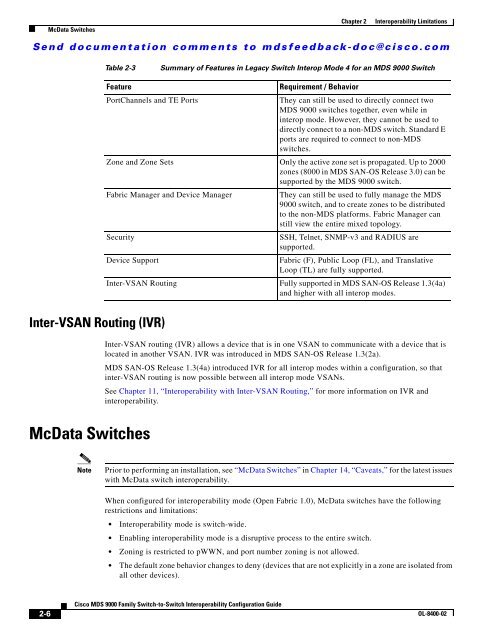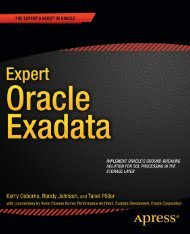Cisco MDS 9000 Family Switch-to-Switch Interoperability ...
Cisco MDS 9000 Family Switch-to-Switch Interoperability ...
Cisco MDS 9000 Family Switch-to-Switch Interoperability ...
You also want an ePaper? Increase the reach of your titles
YUMPU automatically turns print PDFs into web optimized ePapers that Google loves.
McData <strong>Switch</strong>es<br />
Chapter 2<br />
<strong>Interoperability</strong> Limitations<br />
Send documentation comments <strong>to</strong> mdsfeedback-doc@cisco.com<br />
Table 2-3<br />
Summary of Features in Legacy <strong>Switch</strong> Interop Mode 4 for an <strong>MDS</strong> <strong>9000</strong> <strong>Switch</strong><br />
Feature<br />
PortChannels and TE Ports<br />
They can still be used <strong>to</strong> directly connect two<br />
<strong>MDS</strong> <strong>9000</strong> switches <strong>to</strong>gether, even while in<br />
interop mode. However, they cannot be used <strong>to</strong><br />
directly connect <strong>to</strong> a non-<strong>MDS</strong> switch. Standard E<br />
ports are required <strong>to</strong> connect <strong>to</strong> non-<strong>MDS</strong><br />
switches.<br />
Zone and Zone Sets Only the active zone set is propagated. Up <strong>to</strong> 2000<br />
zones (8000 in <strong>MDS</strong> SAN-OS Release 3.0) can be<br />
supported by the <strong>MDS</strong> <strong>9000</strong> switch.<br />
Fabric Manager and Device Manager<br />
Security<br />
Device Support<br />
Inter-VSAN Routing<br />
Requirement / Behavior<br />
They can still be used <strong>to</strong> fully manage the <strong>MDS</strong><br />
<strong>9000</strong> switch, and <strong>to</strong> create zones <strong>to</strong> be distributed<br />
<strong>to</strong> the non-<strong>MDS</strong> platforms. Fabric Manager can<br />
still view the entire mixed <strong>to</strong>pology.<br />
SSH, Telnet, SNMP-v3 and RADIUS are<br />
supported.<br />
Fabric (F), Public Loop (FL), and Translative<br />
Loop (TL) are fully supported.<br />
Fully supported in <strong>MDS</strong> SAN-OS Release 1.3(4a)<br />
and higher with all interop modes.<br />
Inter-VSAN Routing (IVR)<br />
Inter-VSAN routing (IVR) allows a device that is in one VSAN <strong>to</strong> communicate with a device that is<br />
located in another VSAN. IVR was introduced in <strong>MDS</strong> SAN-OS Release 1.3(2a).<br />
<strong>MDS</strong> SAN-OS Release 1.3(4a) introduced IVR for all interop modes within a configuration, so that<br />
inter-VSAN routing is now possible between all interop mode VSANs.<br />
See Chapter 11, “<strong>Interoperability</strong> with Inter-VSAN Routing,” for more information on IVR and<br />
interoperability.<br />
McData <strong>Switch</strong>es<br />
Note<br />
Prior <strong>to</strong> performing an installation, see “McData <strong>Switch</strong>es” in Chapter 14, “Caveats,” for the latest issues<br />
with McData switch interoperability.<br />
When configured for interoperability mode (Open Fabric 1.0), McData switches have the following<br />
restrictions and limitations:<br />
• <strong>Interoperability</strong> mode is switch-wide.<br />
• Enabling interoperability mode is a disruptive process <strong>to</strong> the entire switch.<br />
• Zoning is restricted <strong>to</strong> pWWN, and port number zoning is not allowed.<br />
• The default zone behavior changes <strong>to</strong> deny (devices that are not explicitly in a zone are isolated from<br />
all other devices).<br />
2-6<br />
<strong>Cisco</strong> <strong>MDS</strong> <strong>9000</strong> <strong>Family</strong> <strong>Switch</strong>-<strong>to</strong>-<strong>Switch</strong> <strong>Interoperability</strong> Configuration Guide<br />
OL-8400-02











